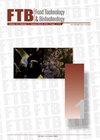Synthesis of Pyrodextrins and Enzymatically Resistant Maltodextrins from Makal (Xanthosoma yucatenensis) Starch
IF 2.5
4区 农林科学
Q3 BIOTECHNOLOGY & APPLIED MICROBIOLOGY
引用次数: 0
Abstract
Research background. Enzymatically resistant maltodextrins (ERM) are a resistant starch (RS) type 4, synthesized from native starch. They are obtained through sequential application of two processes: pyrodextrinization (PDX), which produces pyrodextrins, and complementary hydrolysis (CH), which generates ERM. These processes produce atypical bonds and confer characteristics similar to dietary fiber to pyrodextrins and ERM, such as resistance to digestion. The objective of this work was to obtain and evaluate some physicochemical characteristics of pyrodextrins and ERM produced from native starch isolated from makal (Xanthosoma yucatanense) tubers. Experimental approach. PDX and CH were performed by applying factorial designs. For PDX, factors and their levels were starch concentration/2.2 M HCl ratio (80/1 and 160/1 m/V), temperature (90 and 110 °C), and reaction time (1 and 3 h); while for CH were α-amylase-pyrodextrin concentration (0.5 and 1 µL/mL) and reaction time (10 and 30 min). The physicochemical profile included determination of RS content, estimation of color change (ΔE), microscopy, and determination of dextrose equivalents (DE). Results and conclusions. The best factorial treatment for PDX was at the 160:1 m/V, 90 °C and 3 h levels since it presented the highest RS content (84.73 %) and a lowest ΔE (3.742). Due to its low DE (13.89 %), increased RS (90.73 %), and low ΔE (4.24), ERM resulting from CH with the 0.5 µL/mL α-amylase pyrodextrin concentration and 10 min levels was selected as the best treatment. Novelty and scientific contribution. Results show that pyrodextrins and ERM obtained from makal can be used as ingredients for functional foods development, due to their high proportion of non-digestible material and low browning degree.从马卡尔(Xanthosoma yucatenensis)淀粉合成焦糊糊精和耐酶麦芽糊精
研究背景。酶法抗性麦芽糊精(ERM)是一种抗性淀粉(RS),由天然淀粉合成。抗性麦芽糊精是由原生淀粉合成的抗性淀粉(RS)的第 4 类,通过连续应用两种工艺获得:热糊精化(PDX)和互补水解(CH),前者产生热糊精,后者产生抗性麦芽糊精。这些过程会产生非典型键,并赋予焦糊糊精和 ERM 类似于膳食纤维的特性,例如耐消化性。这项工作的目的是获得并评估从马卡尔(Xanthosoma yucatanense)块茎中分离出的原生淀粉生产的焦糊精和ERM的一些理化特性。采用因子设计法进行了 PDX 和 CH 试验。PDX 的因素及其水平为淀粉浓度/2.2 M HCl 比率(80/1 和 160/1 m/V)、温度(90 和 110 °C)和反应时间(1 和 3 h);CH 的因素及其水平为 α 淀粉酶-糊精浓度(0.5 和 1 µL/mL)和反应时间(10 和 30 分钟)。理化分析包括测定 RS 含量、估计颜色变化(ΔE)、显微镜检查和测定葡萄糖当量(DE)。结果和结论PDX 的最佳因子处理是在 160:1 m/V、90 °C 和 3 小时的条件下,因为它的 RS 含量最高(84.73%),ΔE 最低(3.742)。由于 DE 值低(13.89 %)、RS 含量高(90.73 %)、ΔE 值低(4.24),使用 0.5 µL/mL α 淀粉酶焦糊糊精浓度和 10 分钟水平的 CH 所产生的 ERM 被选为最佳处理方法。研究结果表明,从马卡尔中提取的焦糊精和ERM可用作开发功能性食品的原料,因为它们的非消化物质比例高,褐变程度低。
本文章由计算机程序翻译,如有差异,请以英文原文为准。
求助全文
约1分钟内获得全文
求助全文
来源期刊

Food Technology and Biotechnology
工程技术-生物工程与应用微生物
CiteScore
3.70
自引率
0.00%
发文量
33
审稿时长
12 months
期刊介绍:
Food Technology and Biotechnology (FTB) is a diamond open access, peer-reviewed international quarterly scientific journal that publishes papers covering a wide range of topics, including molecular biology, genetic engineering, biochemistry, microbiology, biochemical engineering and biotechnological processing, food science, analysis of food ingredients and final products, food processing and technology, oenology and waste treatment.
The Journal is published by the University of Zagreb, Faculty of Food Technology and Biotechnology, Croatia. It is an official journal of Croatian Society of Biotechnology and Slovenian Microbiological Society, financed by the Croatian Ministry of Science and Education, and supported by the Croatian Academy of Sciences and Arts.
 求助内容:
求助内容: 应助结果提醒方式:
应助结果提醒方式:


